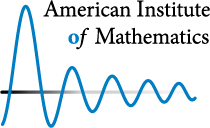3. The peripheral locus
Let $X$ be a cluster variety. Let $T_1,T_2,\dots$ be the cluster tori. Let $P$ denote the complement $X-\cup T_i$.-
Problem 3.1.
When is $P$ empty (in $G(2, 2k+1)$)?
What about the big open positroid cell in $G(k,n)$?-
Remark. [José Simental] P is always empty for the big positroid cell in $Gr(2,2k+1)$.
-
-
Problem 3.2.
When $P$ is nonempty, when do we expect the complement of $P$ to be codimension 2? -
Let $X$ be really full rank. This implies there is a torus of dimension the number of frozen variables acting on $X$ preserving cluster structure. $S$ acts freely on each cluster torus so any point with nontrivial $S$-stabilizers is in $P$.
In $G(k,n)$, nontrivial stabilizers correspond to disconnected matroids. So if $[v_1,\dots, v_n]$ is a $k\times n$ matrix where the matroid of $v_1,\dots, v_n$ is disconnected, this point of $G(k,n)$ is in $P$.Problem 3.3.
Is the converse also true (Is $P$ for the big positroid cell exactly the points with disconnected matroid)?
Cite this as: AimPL: Cluster algebras and braid varieties, available at http://aimpl.org/clusterbraid.
